More Than A Pinprick
Tehelka
June 19, 2010
THE RISK TO INDIA’S NEWBORNS
A SLY FUDGING OF FACTS IS PUSHING INDIA INTO BUYING VACCINES BACKED BY THE WHO THAT MAY HAVE KILLED CHILDREN IN OTHER COUNTRIES
BY VIJAY SIMHA

BABIES, THEY say, are a nice way to start people. They are also, it would appear, a nice way to start profit. If the babies are Indian, there’s added allure to the profit because there are so many of them every year. In the days to come, as the denouement of a series of extraordinary events, the Indian government is expected to make a fresh decision on the number of vaccines Indian infants are to be given soon after birth. Much rests on the decision for Indian families and, oddly, the World Health Organisation (WHO), which has made a bizarre push for new vaccines it wants Indian newborns to be given in the country’s public health programme.
A decision one way could risk the lives of the country’s babies, because there are doubts on the quality of vaccines the WHO is pitching for; it could push the government into financial commitments it is in no position to meet; it could empty the pockets of people who seek private medical help, and put the nation’s health sector more firmly under the control of agencies outside India. A decision the other way could force units formerly run by the Indian government to resume full work and make homegrown vaccines; and thrust more expenses on a feeble state wallet, which will need to fund more R&D.
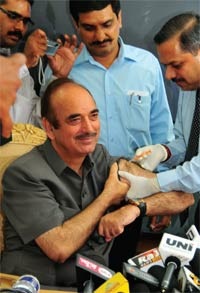 Unsafe shield? Health Minister Ghulam
Unsafe shield? Health Minister Ghulam
Nabi Azad being injected with the
H1N1 flu vaccine; a child waiting for a shot
Photo : NAVEESH TEJPAL
This vaccine soup has been stirred by the WHO, which is in the midst of several controversies of late for creating medical scares and then backing drugs to fight them. In the first week of June, the WHO admitted it had failed to disclose conflict of interest for scientists who advised it on the H1N1 influenza pandemic. The response came after a British media report said the WHO had announced a fake pandemic to boost sales for pharmaceutical companies that manufacture antiviral drugs and the H1N1 vaccine. Now, there appear to be the makings of a similar controversy over what may be taking the shape of an Indian vaccine scam.
The Vaccines
India does not have a well-defined vaccine policy. It has a National Immunisation Programme, under which it conducts an Expanded Programme of Immunisation (EPI). Twenty-five million children are born every year in India. That is a vast vaccine market, far bigger than many countries put together. Only about 53 percent of the children born in India are vaccinated. This means about 11 million children in India, almost wholly from poor families in the hinterlands, still need to be vaccinated every year.
Also, only about 40 percent of the children are born in medical institutions. Here, there is a process laid down for vaccination. A whopping 60 percent of annual Indian births, or 15 million, are in homes or anywhere else. Most of them, in the villages and backwaters of India, are not likely to get vaccinated. Eighty-five percent of all vaccination in India is done by the government. The private sector accounts for the other 15 percent.
India’s EPI covers six primary vaccines: BCG, Bacillus Calmette-Guérin, a vaccine for tuberculosis; DPT, also called the trivalent vaccine, for diphtheria, pertussis (whooping cough) and tetanus; DT, a diphtheria and tetanus vaccine given to children with adverse reactions to pertussis or where there is a family history of seizures or brain disease; TT, tetanus vaccine normally given as DPT or also separately; measles; and polio.
For millions of parents, this is a moment of absolute helplessness. They have created a life and will take no chances with its protection. They will do anything for the newborn. They are like fodder. Those who can afford the private clinics end up paying far more than they should. The private clinics run their own vaccination programme that may differ from the national immunisation policy. For instance, many clinics offer hepatitis B and Hib (Haemophilus influenzae Type B) shots though they are not part of the national programme. This package can cost between Rs 1,500 and Rs 4,000. Doctors in the know say the profit margin is huge. The pharma companies send the pentavalent vaccine to the doctors at, say, Rs 1,000. The MRP might show, say, Rs 525, or even Rs 2,200 depending on the manufacturer. The doctor adds consultation fee, nurse costs, syringe costs and so on.
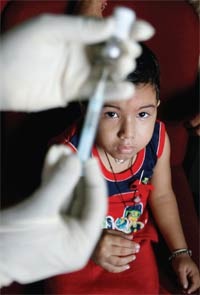 Photo: REUTERS
Photo: REUTERS
Those who go to government centres get the shots free. But, for both the rich and the poor, life revolves for a while around the vaccine shots. A child gets BCG and polio shots at birth. This is followed by DPT shots in the sixth, tenth and fourteenth weeks. Measles vaccination is done between nine months and 15 months. Then, there are DPT and polio doses at 18 months and four-and-a-half years. This is the routine a parent and child go through.
The WHO is entering this landscape and is pushing for an expansion of the trivalent DPT vaccine into a pentavalent vaccine by including two other diseases, hepatitis B and Hib, based on motives and theories that are being questioned. Switching to pentavalent would force India to shut its public sector units and depend entirely on the pricing whims of the private sector.
The Cost
The WHO push for a pentavalent vaccine in India’s public health policy is based on two arguments: that Hib and hepatitis B exist in India to an extent enough for public vaccination, and that the pentavalent vaccine works in other countries, notably Asian nations like Sri Lanka and Bhutan, in the same geographic zone as India.
This is being seen by Indian experts as an attempt to market vaccines manufactured by big pharmaceutical companies like GlaxoSmithKline Pharmaceuticals Limited, by creating a fake scare of hepatitis B and Hib in India. There is a huge cost factor to this. The WHO is seeking an amendment in our public health policy on immunisation. This means the government will have to pay for the pentavalent vaccine when it has no money.
This is a perpetual expense as children are born all the time. Currently, the Indian government procures the trivalent vaccine at around Rs 15 from Indian firms. The WHO-backed pentavalent vaccine will cost Rs 525 at UNICEF-negotiated prices. Then, there will be additional costs for handling and delivering , which makes the pentavalent vaccine 35 times costlier than the trivalent vaccine. That is Rs 735 crore in cost of vaccine alone in perpetuity every year, and increasing due to inflation.
Appallingly, there is no concern for the 11 million or so Indian children who are not vaccinated because they are too poor to afford private care, and because the government has not yet established systems to reach them. So, while a massive number of children are already suffering, the push for a pentavalent vaccine only increases costs of existing vaccines.
“Why should we go for something that is 35 times costlier when we are unable to even administer the existing vaccines? There is much greater burden in India of diphtheria, tetanus and pertussis (whooping cough) compared to hepatitis B and Hib. Cases of diphtheria are rising in India and we haven’t yet got a grip on child mortality. Why then are we even considering the pentavalent vaccine?” says Dr Sanjeev Singh, an advisor to several hospitals in Delhi and who has worked in preventive and social medicine.
Singh says India’s trivalent vaccine is failing because of several reasons that need urgent attention. “Vaccines need to be maintained at a specific temperature. They go from a pharma company to the government of India, which then sends them to state governments. From here, the vaccines are sent to district centres and from there to primary health centres and anganwadi workers who carry them to homes. We do not have a cold chain system that can keep the vaccines at the temperature they need. So the vaccines fail. This is a top priority area. Then, we don’t have enough doctors, nurses and other workers. Those we have are not trained well. This is a disaster that needs immediate investment of money and skills,” says Singh.
Somebody needs to make the pentavalent vaccine on a scale that India needs, should the WHO convince the Union government to go for it. The Indian firms that make the trivalent vaccines have only recently reopened under pressure from a group of concerned experts after they were shut by the first government of the United Progressive Alliance (UPA). Now, the WHO wants hepatitis B and Hib vaccines added, which these Indian firms have no expertise at making. This is where the friends of the WHO, organisations and companies based largely in the US, come in. It is most likely that the pentavalent vaccine will then come from agencies and companies outside India. This is worrisome.
The Deaths
The economic burden of a pentavalent vaccine is a bother, but less so when seen in the light of what happened in Sri Lanka and Bhutan, where the WHO got the governments to use a pentavalent vaccine. In Bhutan, the government stopped the use of the pentavalent vaccine just two months after it was introduced. In late October 2009, the Bhutan health ministry sent an urgent circular to various centres and clinics saying: “The use of pentavalent vaccine should be stopped immediately due to some side effects. All adverse events following immunisation (AEFI) must be reported and investigated.”
POLIO PARALYSIS
The Trouble With The Polio Vaccine
More cases are being reported from Bihar and Uttar Pradesh despite increased doses
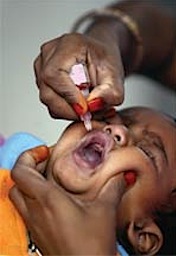
IT’S NOT JUST the proposed-pentavalent vaccine that is causing problems. India’s Pulse Polio Immunisation programme is apparently not showing the results it was expected to. The worst states for polio in India, Uttar Pradesh and Bihar are now reporting more cases of Acute Flaccid Paralysis (AFP), even from last year, even though the doses have been increased.
The AFP rate is the number of persons paralysed per 100,000 population. Ordinarily, it is expected to be one or two per 100,000. But, the official figures of the National Polio Surveillance Project (NPSP), a joint effort of the union government and the WHO, show that the number of AFP cases by the first week of June 2009 were 4,280 in Bihar. This year, the figure has gone up to 5,190, which is a 21.26 percent increase. In Uttar Pradesh, the AFP cases have gone up from 5,286 in June 2009 to 6,824 in June this year. This represents a 22.54 percent increase.
Almost all cases of AFP are seen as polio. “When we refer to AFP, we take it polio although not all AFP cases are caused by the polio virus. But a majority would be,” says Dr Sanjeev Singh, an advisor to many hospitals in Delhi. Singh says he can barely recall two cases of non-polio AFP over several years of work.
However, the NPSP says only six of the 5,190 AFP cases from Bihar are confirmed polio cases so far this year. It also says it has discarded 4,266 cases as not polio and that 918 cases are pending. Likewise, in Uttar Pradesh the NPSP is confirming only 10 cases of AFP as polio so far adding it has discarded 5,362 cases as not polio and 1,450 cases are pending.
Another reason given for the increase in polio cases even after a massive Pulse Polio Immunisation programme is that there is better surveillance now, people are more aware, and they are therefore reporting more cases now. If that were so, there is all the possibility of far more polio cases being discovered. This, in turn, raises doubts over the efficacy of the polio vaccine.
In 2007, TEHELKA reported that a new polio vaccine was introduced without informing the public and the the AFP rate in Uttar Pradesh rose from 3,789 in 2004 to 10,055 in 2005, when six doses of oral polio vaccine were given, and to 11,538 in 2006 when a further nine doses were administered.
In 2006, the AFP rate in Uttar Pradesh was 16.87 per 100,000. Today, it is 22. In Bihar it is 32. So, is the repeated vaccination in these states, which are receiving more doses, responsible? AFP is no mild disease. About half the cases are permanently paralysed, says an analysis in the journal Indian Pediatrics. It appears that the polio vaccine is another example of the government ceding to international agencies, who are pushing for more doses.
The ban is still effective on pentavalent vaccine in Bhutan and the system has gone back to the trivalent vaccine that they used before the WHO plugged for the pentavalent vaccine. It was the first time a vaccine was halted in Bhutan after the country launched its EPI in 1979. Bhutan got over 30,000 pentavalent vaccines from GAVI, the Global Alliance for Vaccine Initiative. GAVI was formed in 2000 and includes governments, corporate giants, donor institutions, the Bill & Melinda Gates Foundation, vaccine manufacturers, research and technical institutes, civil society organisations, the WHO, the UNICEF, and the World Bank.
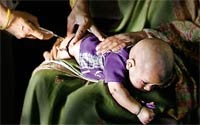
Beginnings A health worker gives polio drops
to a child in Allahabad (above); A baby gets his shots in an Indore hospital
Photo: KAILASH MITTAL
A Delhi-based drugmaker, Panacea Biotec, was one of the pentavalent vaccine suppliers to Bhutan. Its stock, sold as EasyFive, was taken off the shelves after four children who were given it died. Panacea had won a $222 million contract to supply the pentavalent vaccine to UNICEF up to 2012. The deaths in Bhutan forced the Drug Controller General of India (DCGI), the country’s drug chief, to ask paediatricians to prescribe EasyFive with caution and report adverse effects, if any. After their Bhutan probe, the WHO said it found no link between EasyFive and the deaths in Bhutan. Till very recently, WHO officials have been telling Bhutan that the deaths were due to encephalitis. The issue hasn’t been sorted out yet.
Something similar happened in Sri Lanka in 2008 when the WHO convinced the government to introduce pentavalent vaccine. Introduced in Sri Lanka in January 2008, it was stopped by April. Five children had died after they were given the vaccine and at least 20 others developed serious complications.
When a vaccine goes wrong, the WHO has an Adverse Events Following Immunisation (AEFI) Causality Assessment. This is the crucial document that explains the link between a vaccine and adverse events after it is administered. The WHO AEFI assessment has six categories: very likely or certain (that the deaths happened because of the vaccine), probable, possible, unlikely, unrelated, and unclassifiable.
In simple terms, ‘very likely or certain’ means an adverse event must follow the vaccine within reasonable time, there must be no other explanation like a concurrent drug or chemical or disease, and, the adverse event must be proved definitely using a re-challenge, meaning the process of vaccination is repeated again. In cases of deaths like in Sri Lanka and Bhutan, a re-challenge is impossible. So, it becomes easier to blame the death on other factors.
‘Probable or likely’ means an adverse event must follow the vaccine within reasonable time, there must be no other explanation for the event like a concurrent drug, chemical or disease, and re-challenge information is not required. A ‘possible’ situation is where an event must follow the vaccine within reasonable time, and may also be explained by a concurrent drug, chemical or disease. ‘Unlikely’ is where there is the time after a vaccine is given may make an event improbable, and another drug, chemical, or disease provides plausible explanation. ‘Unrelated’ is where the time between an event and a vaccine administration makes the link incompatible, and where another drug, chemical or disease explains the event. ‘Unclassifiable’ is where too little is known.
In Sri Lanka, the WHO sent an expert panel to investigate the deaths. This panel classified the link between the deaths and the pentavalent vaccine under four heads: very likely or certain, unlikely, unrelated and unclassifiable. They removed the two important categories, probable and possible. This changes everything. In the case of deaths you can never re-challenge the situation because the child is dead. So, you cannot establish the vaccine-death link again. This means they are classified as ‘probable’ or ‘possible’, which is good enough to stop a vaccine and take another look.
Now, with the removal of these two categories, all deaths become unlikely (due to a vaccine) because that is the next classification available. The WHO panel thus reported that three deaths in Sri Lanka were unlikely to have been caused by the pentavalent vaccine, one was unrelated and one was unclassifiable.
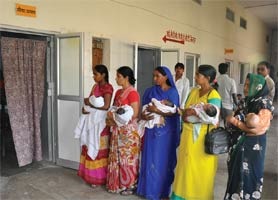 Mothers’ day out Women wait with infants at a Kanpur government health clinic for early vaccinations
Mothers’ day out Women wait with infants at a Kanpur government health clinic for early vaccinations
photo:GP AWASTHI
Of relevance to India is what the government did in the Delhi High Court on a Public Interest Litigation on how irrational vaccines are being introduced in India. On April 3, the government told the court that there was nothing wrong with the WHO-backed pentavalent vaccine and attached the WHO panel’s Sri Lanka report as evidence. So the altered probe parameters are what the Indian government will judge future vaccine issues by. In case of deaths then, a link between a vaccine and the adverse event may never be established in India because there is no such clause anymore. On this rests the direction in which India’s vaccination policy may be headed.
When asked why the parameters were altered, WHO Group Leader for Global Vaccine Safety, Patrick Zuber, told TEHELKA: “WHO provides a guideline for a six-point classification of the potential causal association between an AEFI and vaccination but it is important to note that this classification is not intended to be used on its own. Case classification is the result of a full evaluation of all clinical and epidemiological data available. WHO’s proposed system is not the only one available as a number of regulatory and safety expert groups use other scales for the assessment and classification of cases with regard to the potential causal link between AEFI and vaccines.
Benefiting from the experience of its members in the field of causality assessment, the panel proposed to simplify the categories of causality in the current assessment based on all these factors and provided its definitions in the report. In this particular instance, of the 13 cases reviewed (deaths and non-death complications), four were classified as unlikely related to the vaccine and five were considered unrelated. Four could not be classified because of insufficient information. Clearly, none would have been considered as probable or possible associations. More importantly, this investigation did not yield any new evidence suggesting that an unusual safety problem could have occurred in relationship with the use of pentavalent vaccine. Since then, Sri Lanka has resumed use of the product with no new safety signal to our knowledge.”
Now, no other cause of death has been established in the Sri Lanka cases. So, listing them as unrelated is not justified. In the earlier WHO classification, they would have been listed as likely to have been related to the vaccine and that would have led to a fresh review. Now, none of that is possible and this in turn makes it easier for the WHO to push vaccines into India.
The Fudge
To make a pitch for the pentavalent vaccine in India, the WHO needed to establish the prevalence of hepatitis B and Hib to the extent needed for public immunisation. It was bafflingly done. In 2000, an article appeared in a journal called Health Economics, written by Mark Miller from Atlanta, USA. The article said 250,000 people die in India every year of liver cancer caused by hepatitis B. This figure was astonishingly arrived at by using data from Taiwan on India.
The article said one in four carriers of hepatitis B dies of liver cancer in Taiwan. However, the strain of the hepatitis B virus in Taiwan is different from that in India. Also, data from the Indian Council of Medical Research (ICMR) suggests the strain of hepatitis B in India causes liver cancer in only one out of 100 carriers of hepatitis B. This means the death rate in India of liver cancer due to hepatitis B is 10,000 a year. This is a minor percentage of the nearly 25 million deaths in India every year, of many reasons. It is too low to warrant public hepatitis B immunisation and may have led the WHO into exaggerating the figure 25 times.
A paediatrician from Delhi’s St. Stephens Hospital, Jacob Puliyel, challenged Miller’s theory. Miller couldn’t prove what he wrote and finally said the model on which he based his findings was lost. Strangely, the WHO reasoning for a hepatitis B vaccine in India is similar to that in Miller’s article. “He was using a fake model,” Puliyel said.
The WHO argument for a Hib vaccine is based on a 2006 UNICEF report, Pneumonia: The forgotten killer of children, which said 14 out of every 1,000 children in India under the age of five die of pneumonia. However, an ICMR study in 2005 showed the death rate was just 0.26 per thousand in India. The ICMR study was done in three centres, Chennai, Ahmedabad, and Chandigarh. It found that all cases of pneumonia were just 30 per thousand and that of meningitis were 20 per thousand. Hib is the principal cause of pneumonia and meningitis, therefore the focus on these two diseases.
Even if there were a 10 percent mortality rate in pneumonia cases, it would still be only three deaths per thousand from pneumonia. This is 50 times lower than the UNICEF figure and, again, far too low for public immunisation. Thus, there is something seriously amiss about the argument for a pentavalent vaccine, especially when it might lead to death. In any case, the vaccine’s efficacy is not established beyond doubt.
Where it Stands
The ICMR is expected to take a decision on the pentavalent vaccine soon. It has held three meetings on this. There is a National Technical Advisory Group on Immunisation (NTAGI), which is responsible for advising the government. The ICMR formulates research based on this advice.
Fighting against the move to introduce controversial vaccines is a group of experts. They include: KB Saxena, former Union health secretary; SK Mittal, former head of paediatrics, Maulana Azad Medical College, New Delhi; Debabar Banerji, Professor Emeritus, Centre of Social Medicine and Community Health, Jawaharlal Nehru University; Imrana Qadeer, member, Population Council; NJ Kurian, former advisor, Union Ministry of Finance; Ritu Priya, advisor, National Rural Health Mission; Mira Shiva, member, Central Social Welfare Board; Jacob Puliyel, head, Paediatrics Department, St Stephens Hospital, Delhi; and Gopal Dabade, president, Drug Action Forum, Karnataka.
In July, the ICMR will formally advise the health ministry on the pentavalent vaccine. Trust they will choose life over profit.
WRITER’S EMAIL:
From Tehelka Magazine, Vol 7, Issue 24, Dated June 19, 2010